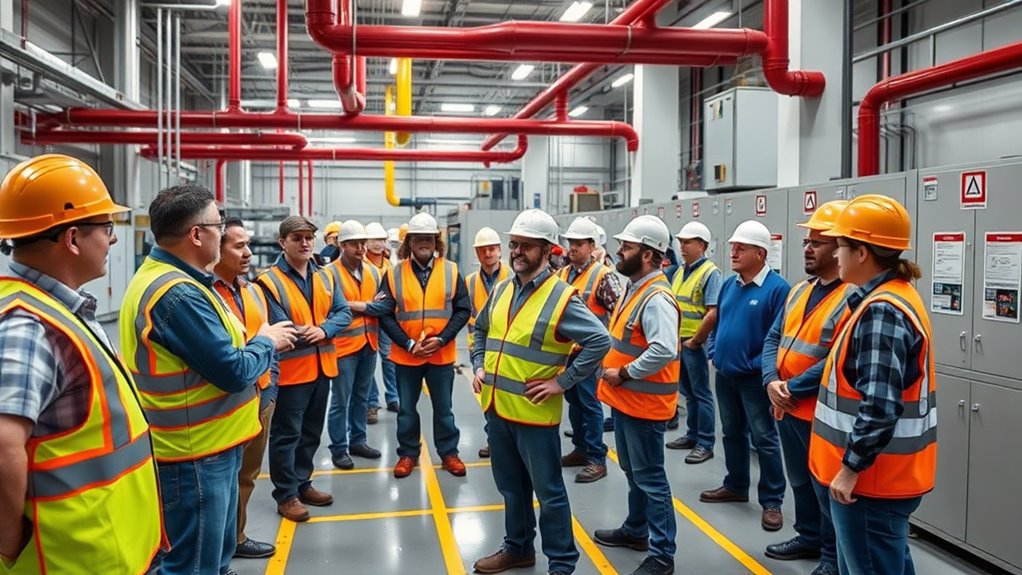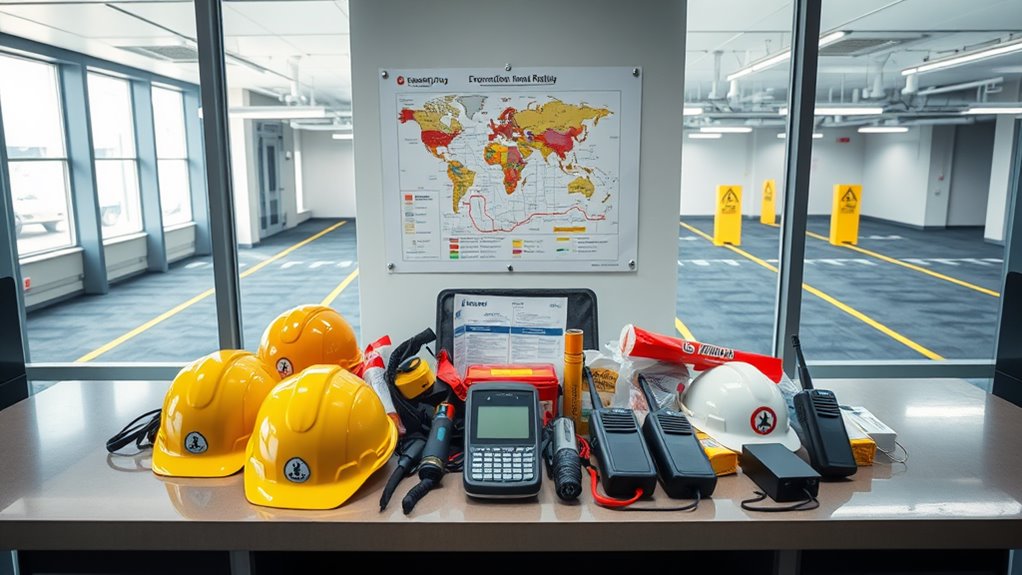Essential workplace safety and liability prevention plans are critical for safeguarding employees and minimizing risks. These plans should incorporate compliance with regulations, systematic risk assessments, and thorough safety protocols. Regular employee training on safety practices and robust emergency response plans are crucial. Additionally, ongoing reviews and updates to safety measures guarantee relevance and effectiveness. Engaging employees in safety discussions fosters a culture of accountability and awareness. Further exploration reveals additional strategies for enhancing workplace safety and liability management.
Key Takeaways
- Implement comprehensive safety protocols that include regular audits and hazard identification to proactively mitigate risks.
- Conduct frequent risk assessments to prioritize safety measures based on the likelihood and impact of potential hazards.
- Develop and practice effective emergency response plans, ensuring employees are trained and confident in their roles during crises.
- Foster a culture of safety through employee engagement, regular training sessions, and recognition programs to promote adherence to safe practices.
- Regularly review and update safety plans in collaboration with employees to address new hazards and align with regulatory changes.
Understanding Workplace Safety Regulations

Although workplace safety regulations can vary greatly across different industries, understanding these guidelines is essential for maintaining a safe environment. Organizations must prioritize regulatory compliance to safeguard employees and minimize liability risks. Regular workplace inspections play a crucial role in identifying potential hazards, ensuring that safety measures align with established standards. By fostering a culture of safety, companies can not only protect their workforce but also enhance productivity and morale. Employees should be encouraged to report unsafe conditions, creating a proactive approach to safety. Staying informed about relevant regulations empowers management to implement effective safety protocols, ultimately contributing to a more secure workplace. A commitment to understanding and adhering to safety regulations is a fundamental component of any successful business strategy. Furthermore, conducting business investigations can help identify risks and enhance safety measures within the organization.
Conducting Risk Assessments
Conducting risk assessments is an essential component of workplace safety management. This process involves systematic hazard identification, where potential risks associated with various tasks and environments are recognized. By evaluating these hazards, organizations can effectively prioritize risks based on their likelihood and potential impact on employee safety. Utilizing a structured approach aids in addressing the most pressing concerns first, fostering a safer work environment. Engaging employees in discussions about their experiences and observations enhances the assessment process, as they often possess valuable insights. Regularly scheduled risk assessments guarantee that safety measures evolve alongside workplace changes, reinforcing a culture of proactive safety. Through diligent risk prioritization, organizations can minimize liabilities and protect their workforce, ultimately promoting a healthier, more secure workplace. Additionally, establishing strong internal controls is crucial for safeguarding against risks that may arise during assessments and operations.
Developing Comprehensive Safety Protocols
A thorough safety protocol is essential for ensuring a secure work environment. Organizations must prioritize developing extensive safety protocols that encompass regular safety audits and effective hazard identification processes. By conducting safety audits, companies can systematically evaluate their existing safety measures, revealing potential weaknesses and areas for improvement. Concurrently, a robust hazard identification strategy allows teams to proactively recognize and mitigate risks before they escalate into serious incidents. This dual approach fosters a culture of safety, encouraging employees to engage actively in their well-being. Ultimately, extensive safety protocols not only protect individuals but also enhance overall organizational efficiency, ensuring that safety remains a core value within the workplace. Additionally, implementing fraud prevention strategies is crucial for safeguarding against internal and external risks that can threaten workplace safety. Creating such protocols is a critical step toward a sustainable and secure operational environment.
Training Employees on Safety Practices

Training employees on safety practices is essential for maintaining a secure workplace environment. This includes providing a thorough overview of safety protocols as well as implementing hands-on training sessions to reinforce knowledge. Such initiatives not only enhance employee awareness but also substantially reduce the risk of accidents and liabilities. Additionally, fostering a culture of trust and accountability can further mitigate potential risks in the workplace.
Safety Protocol Overview
Implementing effective safety protocols is essential for fostering a secure work environment. Training employees on safety practices begins with extensive hazard identification, which equips them to recognize potential risks before they escalate. This proactive approach guarantees that all team members are aware of their surroundings and the importance of using appropriate safety equipment. Regularly scheduled training sessions reinforce these concepts, emphasizing the value of vigilance and responsibility. Employees should also be encouraged to report any unsafe conditions immediately, creating a culture of safety that prioritizes well-being. By investing in thorough training, organizations can greatly reduce workplace accidents and enhance overall productivity, ultimately fostering a sense of trust and security among the workforce.
Hands-on Training Sessions
Engaging employees in hands-on training sessions markedly enhances their understanding of safety practices in the workplace. These sessions often incorporate hands-on simulations and interactive workshops, allowing employees to actively participate in safety protocols rather than merely observing them. This experiential learning approach fosters retention and empowers employees to respond confidently in real-life scenarios. By utilizing realistic situations, individuals can practice their skills in a supportive environment, reinforcing the importance of safety measures. Additionally, these workshops promote collaboration and communication among team members, creating a culture of safety and accountability. Organizations that prioritize such training demonstrate their commitment to employee well-being, ultimately reducing the risk of workplace accidents and liabilities.
Implementing Emergency Response Plans

Establishing effective emergency response plans is essential for ensuring workplace safety and minimizing potential liabilities. Organizations must develop thorough strategies that outline procedures for various crises, including natural disasters, medical emergencies, and workplace violence. Regularly scheduled emergency drills are vital, allowing employees to practice these procedures and gain confidence in their roles during a crisis. This proactive approach not only enhances preparedness but also fosters a culture of safety and teamwork. Additionally, organizations should designate crisis management teams to oversee training and response activities, ensuring clarity in communication and action during emergencies. By prioritizing these plans, businesses can protect their employees and greatly reduce the risk of liability, creating a safer work environment for everyone involved. Furthermore, incorporating surveillance techniques can enhance the effectiveness of these plans by enabling organizations to monitor potential threats in real-time.
Promoting a Culture of Safety
While organizations may have extensive safety protocols in place, fostering a culture of safety is essential for ensuring that these measures are effectively embraced by all employees. This culture is built through strong safety communication and proactive safety leadership. Leaders must model safe behaviors and encourage open dialogue about safety concerns.
Key strategies to promote a culture of safety include:
- Regular safety meetings: Providing forums for discussion and feedback enhances awareness and engagement.
- Recognition programs: Acknowledging safe practices reinforces their importance and motivates others to follow suit.
- Training and resources: Equipping employees with the knowledge and tools they need empowers them to take ownership of their safety. Additionally, it is crucial for employees to be aware of common safety risks that may arise during busy periods, as this knowledge can help them respond effectively to potential threats.
Regularly Reviewing and Updating Safety Plans
Regularly reviewing and updating safety plans is essential for maintaining workplace safety. Organizations should establish a consistent review schedule and actively involve employees in the update process to guarantee that the plans remain relevant and effective. This collaborative approach fosters a culture of safety and encourages continuous improvement in safety practices. Additionally, incorporating proactive investigations into safety reviews can help identify potential risks and enhance overall organizational integrity.
Frequency of Reviews
Consistently reviewing and updating safety plans is essential for maintaining a safe workplace environment. Establishing regular review schedules allows organizations to adapt to changing conditions and guarantee compliance with safety regulations. Frequency analysis reveals that plans should be evaluated at least quarterly, but more frequent reviews may be necessary in dynamic industries.
- Identify new hazards and risks promptly.
- Ascertain employees are aware of updated protocols.
- Align safety measures with regulatory changes.
Involving Employees in Updates
Involving employees in the update process of safety plans greatly enhances their effectiveness and relevance. By actively engaging staff in safety committees, organizations can harness valuable employee feedback that reflects real-world experiences and concerns. This collaborative approach fosters a culture of safety, where employees feel empowered and invested in their work environment. Regular meetings allow for open discussions about potential hazards and suggested improvements, ensuring that safety plans remain current and effective. Additionally, incorporating diverse perspectives from various departments can lead to more thorough strategies that address unique challenges. Ultimately, involving employees not only strengthens safety protocols but also cultivates a sense of community and shared responsibility, essential for a thriving workplace.
Strategies for Liability Prevention and Management
Although workplace safety is paramount, effective strategies for liability prevention and management can greatly reduce risks associated with injuries and accidents. Organizations can implement the following proactive measures:
- Comprehensive liability insurance: Ensuring adequate coverage protects against unforeseen incidents and financial repercussions.
- Robust incident reporting system: Establishing a clear protocol for documenting accidents fosters transparency and aids in identifying patterns for improvement.
- Regular safety training: Ongoing education empowers employees to recognize hazards and adopt safe practices, minimizing potential liability. Additionally, incorporating corporate investigation services can enhance overall security and compliance, further mitigating risks.
Frequently Asked Questions
What Are the Costs Associated With Implementing Safety Plans?
Costs associated with implementing safety plans require thorough cost analysis and strategic budget allocation. This guarantees that resources are effectively utilized, minimizing risks while fostering a secure environment, ultimately enhancing overall operational efficiency and employee well-being.
How Can I Measure the Effectiveness of Safety Protocols?
To measure safety protocol effectiveness, one can conduct regular safety audits and gather employee feedback. These methods provide insights into compliance, identify areas needing improvement, and ultimately enhance overall safety culture within the organization.
What Legal Consequences Can Arise From Safety Violations?
Safety violations can lead to serious legal consequences, including negligence claims from affected parties and regulatory penalties imposed by government agencies. These repercussions can greatly impact a company’s reputation and financial stability, urging proactive compliance measures.
How Often Should Safety Training Be Conducted for Employees?
Safety training frequency should be established based on industry standards and employee engagement levels. Regular sessions, ideally quarterly, enhance knowledge retention and guarantee a proactive approach to workplace safety, fostering a culture of awareness and accountability.
What Resources Are Available for Small Businesses to Improve Safety?
Small businesses can enhance safety through resources such as safety audits and employee feedback systems. These tools foster a culture of proactive safety awareness, ensuring that concerns are addressed and improvements are continually made for a safer workplace.
Conclusion
To summarize, establishing crucial workplace safety and liability prevention plans is imperative for fostering a secure and compliant work environment. By understanding regulations, conducting thorough risk assessments, and implementing robust safety protocols, organizations can greatly reduce hazards. Ongoing employee training and the promotion of a safety-centric culture further enhance preparedness. Regular reviews and updates of safety plans guarantee continuous improvement, while effective liability management strategies protect the organization from potential legal repercussions, ultimately contributing to a safer workplace for all.





